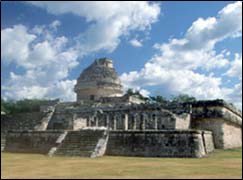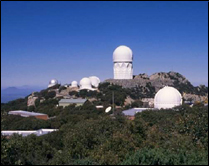Land with a
View:
Finding the Best Places on Earth to Study the Heavens
by
Jake Widman

|
|
Chichen
Itza, Mexico
|
The atmosphere
that surrounds our planet is generally a good thing, everyone
agrees. Besides providing air for us to breathe, is also
protects us from potentially damaging radiation from space.
The ozone layer, for instance, protects us from the ultraviolet
rays of the sun.
When it comes
to observing space, though, the atmosphere becomes a problem.
Stars, galaxies, and other heavenly bodies broadcast information
all along the electromagnetic spectrum, but much of that
information--like some of the sun's UV rays--never gets
to the planet's surface. And the part that does (visible
light, for instance) can be distorted as it passes through
the atmosphere. The history of astronomical observatories
is partly the history of trying to eliminate the difficulties
of seeing through the atmosphere.
Eyes and Ears
on the Heavens
When we hear
the word "observatory," most of us think of a
site dedicated to visual observation of the sky through
what's called an "optical" telescope.
Scientists using
optical telescopes have two main obstacles to overcome.
One is the effect of light pollution--nearby light that
makes it hard to see the sky. This effect is familiar to
anyone who's ever compared the number of stars visible in
the country to the number of stars visible in the city.
The lack of environmental light in a less-inhabited area
makes it possible to see vastly more heavenly objects in
the night sky.
This is partly
why most observatories with optical telescopes are located
out in the country, usually on top of a mountain. That way,
even the lights that might happen to be around will be below
the observatory, where they won't interfere. Kitt Peak National
Observatory, for instance, is situated more than 6,000 feet
(1830 meters) above the Arizona desert, a 90-minute drive
from Tucson. In Chile, the Cerro Tololo Inter-American Observatory,
50 miles (80 kilometers) east of La Serena, is located at
an altitude of over 7200 feet (2200 meters). Observatories
can be found in remote areas all over the world, from the
outback of New Zealand to the desert peaks of Uzbekistan.

|
|
Kitt
Peak Observatory, Arizona
|
The other main
obstacle to visual observation of the sky is light refraction
caused by the atmosphere. The air around our planet is constantly
heating up and cooling down, rising and falling and swirling
around, forming layers of different densities. Each layer
acts like a lens, and as light passes from one of these
layers to the next, the light gets bent, or "refracted,"
even if only a little. The effect is similar to the way
a straw in a glass of water will appear to be shifted sideways
where it breaks the surface.
In the atmosphere,
the shift from one layer of air to the other isn't nearly
that great, but the accumulation of many tiny shifts is
enough to scatter the light and affect the sharpness of
an observed image. Because of this effect, the way we see
objects outside the atmosphere will always be slightly blurred.
Astronomers refer to the quality of their view as their
"seeing": a place that has "good seeing"
offers a less-distorted view than a place that has "bad
seeing." How severe the problem is depends on the atmospheric
conditions in a given location.
The result is
that there's a practical upper limit on how sharp any observation
from earth can be. As a rule of thumb, astronomers estimate
than no earth-bound telescope, no matter how big it is,
can create an image sharper than one made by a six-inch-diameter
telescope (that’s about a hand-span across). Increasing
the size of a telescope's mirror can gather more light to
make faint objects brighter, but the image won’t get
any sharper.
Most important,
putting an observatory on a mountaintop means there’s
less air to see through, so the "seeing" is better.
On a mountaintop, there’s also less air above you to
absorb light from the stars.
The best earthbound
locations for optical telescopes, in fact, are on mountaintops
in the middle of the ocean near the tropics, where temperature
variations are small. That's why, for instance, the Mauna
Kea Observatory is situated on the summit of Mauna Kea,
the "white mountain" on the island of Hawaii,
and the Teide Observatory was built almost 7900 feet (2400
meters) above Tenerife, in the Canary Islands.
The same kinds
of locations can also benefit other kinds of observations.
In the 1930s, astronomers began to aim antennas at the sky
to pick up radio waves from outer space. Unfortunately,
though, nearby human activity can interfere with radio reception
the same way light interferes with visual observation. Television
and radio broadcasts, electric motors, even the signals
from car ignitions can be picked up by radio telescopes.
For that reason, this kind of observatory also functions
best in isolated areas. The Very Large Array, for example,
is located 7000 feet high in a remote area west of Socorro,
New Mexico. In Puerto Rico, the Arecibo Observatory is nestled
in a natural valley surrounded by mountains that shield
it from human activity.
Eyes and Ears
in the Sky

|
|
Hubble
Telescope, NASA image
|
Some electromagnetic
waves--including gamma rays, X-rays, and some kinds of ultraviolet
light--don't get through our atmosphere at all, or are so
scattered by it as to be unreadable. Only from mountaintops
(or higher) do astronomers stand any chance of observing these
wavelengths of light.
To solve these
problems, astronomers have long tried to make observations
from locations off the planet's surface. In 1911-12, the
Austrian researcher Viktor Hess sent instruments up in balloons.
He detected radiation that led him to hypothesize (correctly)
the existence of cosmic rays. After World War II, American
scientists used captured German V-2 rockets to send instruments
up above the ozone layer, enabling them make ultraviolet
and X-ray observations for the first time. Serious work
with aircraft-based observatories began in 1966 and led
to the discovery that Uranus had rings.
In 2009, the
Next Generation Space Telescope will take us to a new level
of cosmological sophistication. But today, the Hubble Space
Telescope represents the current culmination of these efforts.
For the first time, scientists have a permanent astronomical
observatory that's not affected by the problems of light,
atmosphere, or extraneous signals. Of course, operating
a telescope in space creates its own problems, such as the
need for regular servicing missions. But most astronomers
would agree that the results are worth it.
|
![]()
![]()